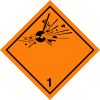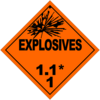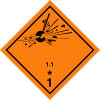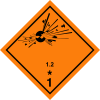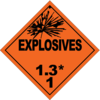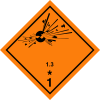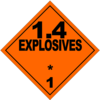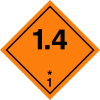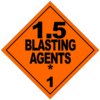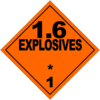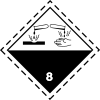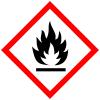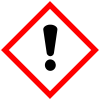A UN number is a four-digit number that identifies hazardous materials, and articles in the framework of international trade and transport. Some hazardous substances have their own UN numbers, while sometimes groups of chemicals or products with similar properties receive a common UN number. A chemical in its solid state may receive a different UN number than the liquid phase if its hazardous properties differ significantly; substances with different levels of purity may also receive different UN numbers.
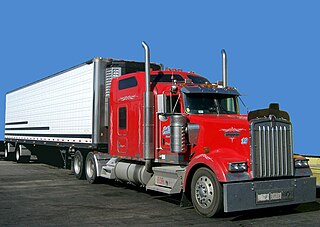
A commercial driver's license (CDL) is a driver's license required in the United States to operate large and heavy vehicles or a vehicle of any size that transports hazardous materials or more than 15 passengers.

Dangerous goods (DG), are substances that when transported are a risk to health, safety, property or the environment. Certain dangerous goods that pose risks even when not being transported are known as hazardous materials. An example for dangerous goods is hazardous waste which is waste that has substantial or potential threats to public health or the environment.

The Emergency Response Guidebook:A Guidebook for First Responders During the Initial Phase of a Dangerous Goods/Hazardous Materials Transportation Incident (ERG) is used by emergency response personnel in Canada, Mexico, and the United States when responding to a transportation emergency involving hazardous materials. First responders in Argentina, Brazil, and Colombia have recently begun using the ERG as well. It is produced by the United States Department of Transportation, Transport Canada, and the Secretariat of Communications and Transportation (Mexico). The principal authors of the ERG are Transport Canada's Michel Cloutier and U.S. DOT's George Cushmac.
A placard is a notice installed in a public place, like a small card, sign, or plaque. It can be attached to or hung from a vehicle or building to indicate information about the vehicle operator or contents of a vehicle or building. It can also refer to paperboard signs or notice carried by picketers or demonstrators.

ORM-D was a marking for mail or shipping in the United States. Packages bearing this mark contained hazardous material in a limited quantity that present a limited hazard during transportation, due to its form, quantity, and packaging. ORM-D was phased out by the US Department of Transportation on January 1, 2021.
Right to know is a human right enshrined in law in several countries. UNESCO defines it as the right for people to "participate in an informed way in decisions that affect them, while also holding governments and others accountable". It pursues universal access to information as essential foundation of inclusive knowledge societies. It is often defined in the context of the right for people to know about their potential exposure to environmental conditions or substances that may cause illness or injury, but it can also refer more generally to freedom of information or informed consent.

The Pipeline and Hazardous Materials Safety Administration (PHMSA) is a United States Department of Transportation agency created in 2004, responsible for developing and enforcing regulations for the safe, reliable, and environmentally sound transportation of energy and other hazardous materials. It is in charge of overseeing about 3.4 million miles of pipelines - accounting for 65% of the energy consumed in the U.S. - and regulating the nearly 1 million daily shipments of hazardous materials by land, sea, and air. This includes pipelines carrying carbon dioxide Carbon capture and utilization). PHMSA's safety programs are housed in the Office of Pipeline Safety (OPS) and the Office of Hazardous Materials Safety (OHMS). PHMSA is headquartered in Washington, D.C.
An oxidizer is a chemical that readily yields oxygen in reactions, thereby causing or enhancing combustion.
Flammable solids are any materials in the solid phase of matter that can readily undergo combustion in the presence of a source of ignition under standard circumstances, i.e. without:
A flammable liquid is a liquid with flash point of not more than 60.5 °C (141 °F), or any material in a liquid phase with a flash point at or above 37.8 °C (100 °F) that is intentionally heated and offered for transportation or transported at or above its flash point in a bulk packaging.
The HAZMAT Class 2 in United States law includes all gases which are compressed and stored for transportation. Class 2 has three divisions: Flammable, Non-Flammable/Non-Poisonous, and Poisonous. This classification is based on the United Nations' Recommendations on the Transport of Dangerous Goods - Model Regulations. In Canada, the Transportation of Dangerous Goods Regulations, or TDGR, are also based on the UN Model Regulations and contain the same three divisions.
The miscellaneous hazardous materials category encompasses all hazardous materials that do not fit one of the definitions listed in Class 1 through Class 8.
A corrosive material is a liquid or solid that causes full thickness destruction of human skin at the site of contact within a specified period of time. A liquid that has a severe corrosion rate on steel or aluminum based on the criteria in 49CFR 173.137(c)(2) is also a corrosive material.
Radioactive substances are materials that emit radiation.
Poisonous material is a material, other than a gas, known to be so toxic to humans that it presents a health hazard during transportation.

In the United States, driver's licenses are issued by each individual state, territory, and the District of Columbia rather than by the federal government due to federalism. Drivers are normally required to obtain a license from their state of residence. All states of the United States and provinces and territories of Canada recognize each other's licenses for non-resident age requirements. There are also licenses for motorcycle use. Generally, a minimum age of 15 is required to apply for a non-commercial driver license, and 25 for commercial licenses which drivers must have to operate vehicles that are too heavy for a non-commercial licensed driver or vehicles with at least 16 passengers or containing hazardous materials that require placards. A state may also suspend an individual's driving privilege within its borders for traffic violations. Many states share a common system of license classes, with some exceptions, e.g. commercial license classes are standardized by federal regulation at 49 CFR 383. Many driving permits and ID cards display small digits next to each data field. This is required by the American Association of Motor Vehicle Administrators' design standard and has been adopted by many US states. According to the United States Department of Transportation, as of 2018, there are approximately 227 million licensed drivers in the United States.

The Hazardous Materials Transportation Act (HMTA), enacted in 1975, is the principal federal law in the United States regulating the transportation of hazardous materials. Its purpose is to "protect against the risks to life, property, and the environment that are inherent in the transportation of hazardous material in intrastate, interstate, and foreign commerce" under the authority of the United States Secretary of Transportation.

In rail transport, the U.S. DOT-111 tank car, also known as the TC-111 in Canada, is a type of unpressurized general service tank car in common use in North America. Tank cars built to this specification must be circular in cross section, with elliptical, formed heads set convex outward. They have a minimum plate thickness of 7⁄16 inch (11.1 mm) and a maximum capacity of 34,500 US gallons. Tanks may be constructed from carbon steel, aluminum alloy, high alloy steel, or nickel plate steel by fusion welding.
Vehicle weight is a measurement of wheeled motor vehicles; either an actual measured weight of the vehicle under defined conditions or a gross weight rating for its weight carrying capacity.


